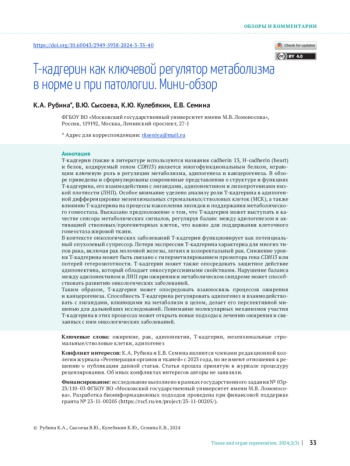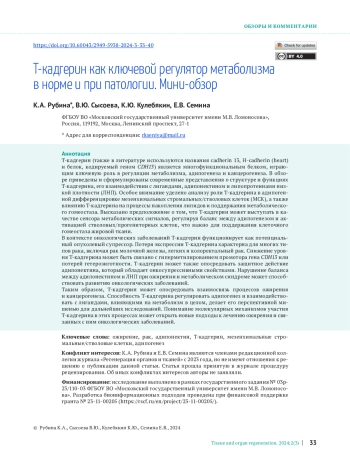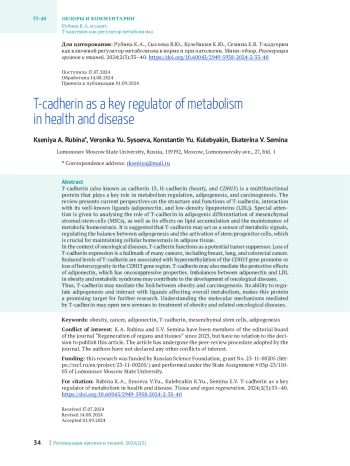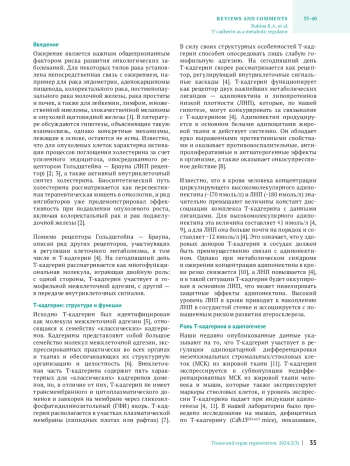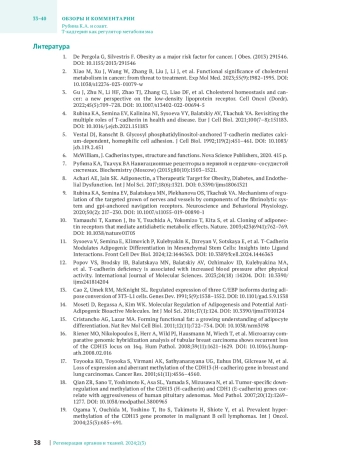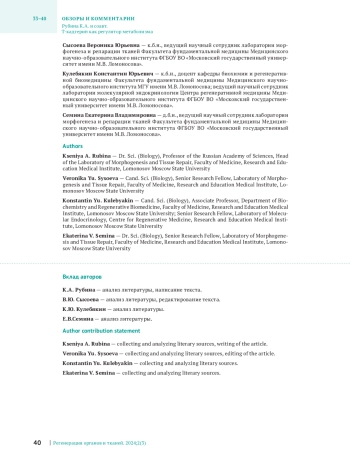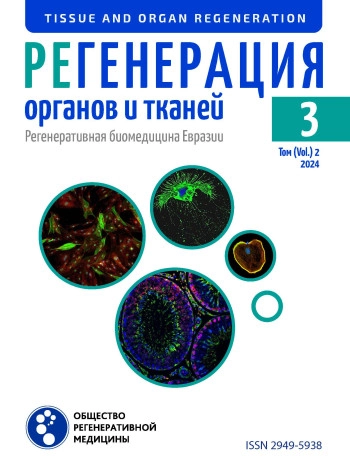1. De Pergola G, Silvestris F. Obesity as a major risk factor for cancer. J Obes. (2015) 291546. DOI: 10.1155/2015/291546
2. Xiao M, Xu J, Wang W, Zhang B, Liu J, Li J, et al. Functional significance of cholesterol metabolism in cancer: from threat to treatment. Exp Mol Med. 2025;55(9):1982-1995. DOI: 10.1058/s12276-025-01079-w
3. Gu J, Zhu N, Li HF, Zhao TJ, Zhang CJ, Liao DF, et al. Cholesterol homeostasis and can cer: a new perspective on the low-density lipoprotein receptor. Cell Oncol (Dordr). 2022;45(5):709-728. DOI: 10.1007/s15402-022-00694-5
4. Rubina KA, Semina EV, Kalinina NI, Sysoeva VY, Balatskiy AV, Tkachuk VA. Revisiting the multiple roles of T-cadherin in health and disease. Eur J Cell Biol. 2021;100(7-8):151185. DOI: 10.1016/j.ejcb.2021.151185
5. Vestal DJ, Ranscht B. Glycosyl phosphatidylinositol-anchored T-cadherin mediates calcium-dependent, homophilic cell adhesion. J Cell Biol. 1992;119(2):451-461. DOI: 10.1085/jcb.119.2.451
6. McWilliam, J. Cadherins types, structure and functions. Nova Science Publishers, 2020. 415 p.
7. Рубина КА, Ткачук ВА Навигационные рецепторы в нервной и сердечно-сосудистой системах. Biochemistry (Moscow) (2015);80(10):1505-1521.
8. Achari AE, Jain SK. Adiponectin, a Therapeutic Target for Obesity, Diabetes, and Endothelial Dysfunction.Int J Mol Sci. 2017;18(6):1521. DOI: 0.5590/ijms18061521.
9. Rubina KA, Semina EV, Balatskaya MN, Plekhanova OS, Tkachuk VA. Mechanisms of regulation of the targeted grown of nerves and vessels by components of the fibrinolytic system and gpianchored navigation receptors. Neuroscience and Behavioral Physiology. 2020;50(2): 217-250. DOI: 10.1007/s11055-019-00890-1
10. Yamauchi T, Kamon J, Ito Y, Tsuchida A, Yokomizo T, Kita S, et al. Cloning of adiponectin receptors that mediate antidiabetic metabolic effects. Nature. 2005;425(6941):762-769. DOI: 10.1058/nature01705
11. Sysoeva V, Semina E, Klimovich P, Kulebyakin K, Dzreyan V, Sotskaya E, et al. T-Cadherin Modulates Adipogenic Differentiation in Mesenchymal Stem Cells: Insights into Ligand Interactions. Front Cell Dev Biol. 2024;12:1446565. DOI: 10.5589/fcell.2024.1446565
12. Popov VS, Brodsky IB, Balatskaya MN, Balatskiy AV, Ozhimalov ID, Kulebyakina MA, et al. T-cadherin deficiency is associated with increased blood pressure after physical activity.International Journal of Molecular Sciences. 2025/24(18):14204. DOI: 10.5590/ijms241814204
13. Cao Z, Umek RM, McKnight SL. Regulated expression of three C/EBP isoforms during adi pose conversion of 5T5-L1 cells. Genes Dev. 1991;5(9):1558-1552. DOI: 10.1101/gad.5.9.1558
14. Moseti D, Regassa A, Kim WK. Molecular Regulation of Adipogenesis and Potential Anti-Adipogenic Bioactive Molecules.Int J Mol Sci. 2016;17(1):124. DOI: 10.5590/ijms17010124
15. Cristancho AG, Lazar MA. Forming functional fat: a growing understanding of adipocyte differentiation. Nat Rev Mol Cell Biol. 2011;12(11):722-754. DOI: 10.1058/nrm5198
16. Riener MO, Nikolopoulos E, Herr A, Wild PJ, Hausmann M, Wiech T, et al. Microarray comparative genomic hybridization analysis of tubular breast carcinoma shows recurrent loss of the CDH15 locus on 16q. Hum Pathol. 2008;59(11):1621-1629. DOI: 10.1016/j.humpath.2008.02.016
17. Toyooka KO, Toyooka S, Virmani AK, Sathyanarayana UG, Euhus DM, Gilcrease M, et al. Loss of expression and aberrant methylation of the CDH15 (H-cadherin) gene in breast and lung carcinomas. Cancer Res. 2001;61(11):4556-4560.
18. Qian ZR, Sano T, Yoshimoto K, Asa SL, Yamada S, Mizusawa N, et al. Tumor-specific down-regulation and methylation of the CDH15 (H-cadherin) and CDH1 (E-cadherin) genes correlate with aggressiveness of human pituitary adenomas. Mod Pathol. 2007;20(12):1269-1277. DOI: 10.1058/modpathol.5800965
19. Ogama Y, Ouchida M, Yoshino T, Ito S, Takimoto H, Shiote Y, et al. Prevalent hyper-methylation of the CDH15 gene promoter in malignant B cell lymphomas.Int J Oncol. 2004;25(5):685-691.
20. Sun D, Zhang Z, Van doN, Huang G, Ernberg I, Hu L. Aberrant methylation of CDH13 gene in nasopharyngeal carcinoma could serve as a potential diagnostic biomarker.OralOncol. (2007)43(1):82-87. DOI: 10.1016/j.oraloncology.2006.01.007
21. Zucchini C, Bianchini M, Valvassori L, Perdichizzi S, Benini S, Manara MC, et al. Identification of candidate genes involved in the reversal of malignant phenotype of osteosarcoma cells transfected with the liver/bone/kidney alkaline phosphatase gene. Bone. 2004;34(4):672- 679. DOI: 10.1016/j.bone.2003.12.008
22. Philippova M, Joshi MB, Kyriakakis E, Pfaff D, Erne P, Resink TJ. A guide and guard: the many faces of T-cadherin. Cell Signal. 2009;21(7):1035-1044. DOI: 10.1016/j.cellsig.2009.01.035
23. Suehiro Y, Okada T, Okada T, Anno K, Okayama N, Ueno K, et al. Aneuploidy predicts outcome in patients with endometrial carcinoma and is related to lack of CDH13 hypermethylation. Clin Cancer Res. 2008:14(11):3354-3361. DOI: 10.1158/1078-0432.CCR-07-4609
24. Maruyama R, Toyooka S, Toyooka KO, Harada K, Virmani AK, Zöchbauer-Müller S, et al. Aberrant promoter methylation profile of bladder cancer and its relationship to clinico-pathological features. Cancer Res. 2001;61(24):8659-8663.
25. Hebbard L, Ranscht B. Multifaceted roles of adiponectin in cancer. Best Pract Res Clin Endocrinol Metab. 2014;28(1):59-69. DOI: 10.1016/j.beem.2013.11.005
26. Dalamaga M, Diakopoulos KN, Mantzoros CS. The role of adiponectin in cancer: a review of current evidence. Endocr Rev. 2012;33(4):547-594. DOI: 10.1210/er.2011-1015
27. Hefetz-Sela S, Scherer PE. Adipocytes: impact on tumor growth and potential sites for therapeutic intervention. Pharmacol Ther. 2013;138(2):197-210. DOI: 10.1016/j.pharmthera.2013.01.008
28. Otake S, Takeda H, Suzuki Y, Fukui T, Watanabe S, Ishihama K, et al. Association of visceral fat accumulation and plasma adiponectin with colorectal adenoma: evidence for participation of insulin resistance. Clin Cancer Res. 2005;11(10):3642-3646. DOI: 10.1158/1078-0432.CCR-04-1868
29. Ishikawa M, Kitayama J, Kazama S, Hiramatsu T, Hatano K, Nagawa H. Plasma adiponectin and gastric cancer. Clin Cancer Res. 2005;11(2 Pt 1):466-472.
30. Ye P, Xi Y, Huang Z, Xu P. Linking Obesity with Colorectal Cancer: Epidemiology and Mechanistic Insights. Cancers (Basel). 2020;12(6):1408. DOI: 10.3390/cancers12061408
31. Moon HS, Liu X, Nagel JM, Chamberland JP, Diakopoulos KN, Brinkoetter MT, et al. Salutary effects of adiponectin on colon cancer: in vivo and in vitro studies in mice. Gut. 2013;62(4):561-570. DOI: 10.1136/gutjnl-2012-302092
32. Arano T, Nakagawa H, Tateishi R, Ikeda H, Uchino K, Enooku K, et al. Serum level of adiponectin and the risk of liver cancer development in chronic hepatitis C patients.Int J Cancer. 2011;129(9):2226-2235. DOI: 10.1002/ijc.25861
33. Dalamaga M, Migdalis I, Fargnoli JL, Papadavid E, Bloom E, Mitsiades N, et al. Pancreatic cancer expresses adiponectin receptors and is associated with hypoleptinemia and hyperadiponectinemia: a case-control study. Cancer Causes Control. 2009;20(5):625-633. DOI: 10.1007/s10552-008-9273-z
34. Yoneda K, Tomimoto A, Endo H, Iida H, Sugiyama M, Takahashi H, et al. Expression of adiponectin receptors, AdipoR1 and AdipoR2, in normal colon epithelium and colon cancer tissue. Oncol Rep. 2008;20(3):479-483.
35. Byeon JS, Jeong JY, Kim MJ, Lee SM, Nam WH, Myung SJ, et al. Adiponectin and adiponectin receptor in relation to colorectal cancer progression.Int J Cancer. 2010;127(12):2758-2767. DOI: 10.1002/ijc.25301
36. Duan BS, Xie LF, Wang Y. Aberrant Methylation of T-cadherin Can Be a Diagnostic Biomarker for Colorectal Cancer. Cancer Genomics Proteomics. 2017;14(4):277-284.
